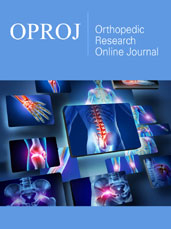- Submissions

Full Text
Orthopedic Research Online Journal
Reevaluating ReveL Osteotomy: Gait, Function and Long-Term Outcomes in Hallux Valgus Correction
Muhammad Khubaib Iftikhar* and Qurat ul ain Iftikhar
Islamic International Medical College, Riphah International University, Pakistan
*Corresponding author:Muhammad Khubaib Iftikhar, MBBS, Islamic International Medical College, Riphah International University, Rawalpindi, Pakistan
Submission: April 07, 2025;Published: April 11, 2025

ISSN: 2576-8875 Volume11 Issue 5
Abstract
Keywords:Hallux valgus; ReveL osteotomy; Pedobarography; Functional outcomes; Recurrence risk; Postoperative rehabilitation; Gait analysis; Minimally invasive surgery
Opinion
We read with great interest the study by Cissé et al. [1] which presents the outcomes of simultaneous bilateral isolated hallux valgus correction using the ReveL distal metatarsal osteotomy. The authors provide valuable insights into clinical, radiological, and pedobarographic results over a minimum two-year follow-up. However, we believe certain methodological aspects and clinical considerations warrant further discussion.
Firstly, while the study evaluates radiological correction parameters, a more comprehensive analysis of functional outcomes would have strengthened its conclusions. Hallux valgus correction is not solely about angular correction but also about long-term pain relief, joint mobility, and patient satisfaction. Validated scoring systems such as the Manchester-Oxford Foot Questionnaire (MOXFQ) or the Foot and Ankle Outcome Score (FAOS) would have added depth to the assessment of patient-reported outcomes [2].
Secondly, the pedobarographic evaluation, though useful, could benefit from comparison with preoperative gait assessments to better delineate biomechanical changes. Previous studies have highlighted that even after radiographic correction, alterations in forefoot loading patterns can persist, potentially predisposing patients to transfer metatarsalgia [3]. A longitudinal pedobarographic follow-up could provide further insights into functional restoration beyond structural realignment.
Furthermore, the study lacks a direct comparative analysis with other established osteotomy techniques, such as the Chevron or Scarf osteotomies. The assertion that the ReveL osteotomy offers superior outcomes would be more robust if supported by randomized controlled comparisons rather than single-cohort observations. Literature suggests that while minimally invasive techniques may reduce soft tissue trauma, concerns regarding stability and recurrence remain [4].
Additionally, there is limited discussion on postoperative rehabilitation protocols and their impact on long-term functional outcomes. Studies indicate that structured rehabilitation programs significantly influence recovery speed and recurrence rates following hallux valgus surgery [5]. Standardizing post-surgical rehabilitation strategies could enhance the overall success of the procedure.
Finally, the study does not address potential long-term complications such as joint stiffness, recurrence rates, or adjacent joint overload. Given that hallux valgus surgery aims to restore long-term function, future investigations with extended follow-up and stratification based on patient-specific factors (e.g., age, activity level) would be beneficial [6].
In summary, while this study contributes to the growing body of literature on hallux valgus correction, a more holistic evaluation encompassing functional outcomes, biomechanical assessments, comparative trials, and standardized rehabilitation protocols is necessary for a conclusive appraisal of the ReveL osteotomy’s efficacy.
References
- Cissé A, Blanc N, Cissé-Gerelle G, Jolles BM, Vienne P (2025) Simultaneous bilateral isolated hallux valgus correction using the revel distal metatarsal osteotomy: Clinical, radiological and pedobarographic evaluation with a minimum of 2 year follow up. Ortho Res Online J 11(4): 1286-1296.
- Dawson J, Doll H, Coffey J, Jenkinson C (2007) Responsiveness and minimally important change for the Manchester-Oxford foot questionnaire (MOXFQ) compared with AOFAS and SF-36 assessments following surgery for hallux valgus. Osteoarthritis and Cartilage 15(8): 918-931.
- Nix SE, Vicenzino BT, Collins NJ, Smith MD (2013) Gait parameters associated with hallux valgus: a systematic review. J Foot Ankle Res 6(1): 9.
- Ji L, Wang K, Ding S, Sun C, Sun S, et al. (2022) Minimally invasive vs. open surgery for hallux valgus: A meta-analysis. Front Surg 9: 843410.
- Schuh R, Hofstaetter SG, Adams SB, Pichler F, Kristen KH, et al. (2009) Rehabilitation after hallux valgus surgery: importance of physical therapy to restore weight bearing of the first ray during the stance phase. Phys Ther 89(9): 934-945.
- Ezzatvar Y, López-Bueno L, Fuentes-Aparicio L, Dueñas L (2021) Prevalence and predisposing factors for recurrence after hallux valgus surgery: A systematic review and meta-analysis. J Clin Med 10(24): 5753.
© 2025 Muhammad Khubaib Iftikhar. This is an open access article distributed under the terms of the Creative Commons Attribution License , which permits unrestricted use, distribution, and build upon your work non-commercially.
 a Creative Commons Attribution 4.0 International License. Based on a work at www.crimsonpublishers.com.
Best viewed in
a Creative Commons Attribution 4.0 International License. Based on a work at www.crimsonpublishers.com.
Best viewed in 







.jpg)






























 Editorial Board Registrations
Editorial Board Registrations Submit your Article
Submit your Article Refer a Friend
Refer a Friend Advertise With Us
Advertise With Us
.jpg)






.jpg)














.bmp)
.jpg)
.png)
.jpg)










.jpg)






.png)

.png)



.png)






